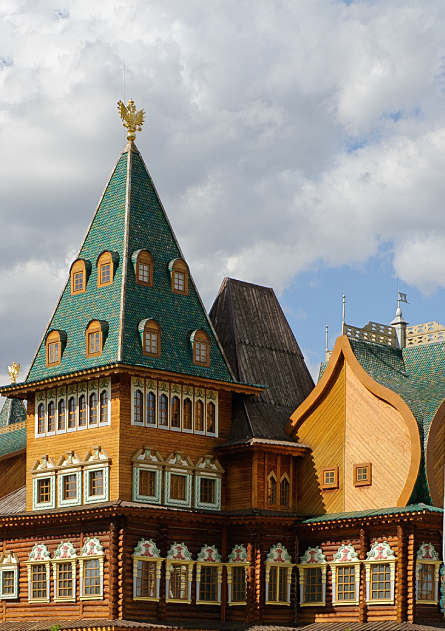
A historically and artistically accurate reconstruction of the XVII century palace
Palace of Tsar Alexey Romanov
KolomenskoeThe authentic Palace of Tsar Alexey Romanov used to be the center of the XVII – XVIII century royal country residence at Kolomenskoe. Contemporaries would call it ‘the eighth wonder of the world’. Standing for a hundred years, it was disassembled by order of Empress Catherine II as ‘worn out by age’. Yet, in 2010, thanks to surviving drawings and measurements, it was successfully reconstructed.
The authentic palace construction started in 1666, under Tsar Alexey, and continued in the reign of his son, Feodor III. All the works were put in charge of Semyon Petrov, carpenter headman, and Ivan Mikhailov, chief of the Streltsy (guardsmen). The best of house builders were invited for construction while most skilful carvers, carpenters and icon painters worked on the palace interiors.
Contemporaries would compare the result to a ‘toy out of the chest’ and would call the new royal palace ‘the eighth wonder of the world’. The variety of its décor remains impressive even today: here you see roofs of most fanciful shapes (tents, cubes, onions, helmets, barrels and half-barrels), shining weathercocks, endless rows of windows and porches richly decorated with carving.
The low ground floor (in old sources ‘down chambers’) was intended for administrative premises while the Tsar’s family lived on the upper floors (‘above chambers’). The large palace building was divided into two halves – men’s and women’s. On each half, the royal chambers can be easily distinguished from the administrative premises: the chambers’ exterior décor is very rich while the other premises’ walls are simple and smooth. Rectangular and round stoves, quite sophisticated in architecture, faced with green or multi-colored decorative ceramic tiles, made an essential part of the palace interior décor. The ceramists who worked on them came from Yaroslavl, Saint Petersburg and the New Jerusalem Monastery not far from Moscow.
The palace stood on its original place for a hundred years and then was disassembled by order of Catherine II as she found it ‘worn out by age’. Yet, the surviving drawings and measurements, the data of which were confirmed by archaeological research, made the reconstruction possible.
Not to break up the Tsar’s Courtyard architectural complex shaped by nowadays, a decision was taken to reconstruct the palace in the Kolomenskoe Museum’s southern part. More than 200 masters of 20 professions, including wood and ceramic artists, gilders, drapers, upholsterers and embroiderers in gold, were involved in the reconstruction. The entire works took 3 years, from 2007 to 2010.
All the interior reconstruction works rested on thorough studies involving subject matter experts as well as materials and research data of leading foreign and Russian archives and museums: the Russian State Archive of Ancient Acts, the State Historical Museum and its branch – the Romanov Boyars’ Chambers (Moscow), the Moscow Kremlin Museum-Reserve, Kostroma Museum-Reserve, Ostankino Historic House Museum (Moscow), the State Museum of Oriental Art (Moscow),Victoria and Albert Museum (London), Metropolitan Museum (New York), the Museum of Islamic Art (Doha, Qatar), the Museum of Fine Arts (Vienna) and others.
The palace is an accurate reconstruction of the original. It houses an entire museum complex comprising an interior permanent exhibition, temporary exhibition halls, art studios, gift shops and a café.
To learn more about the Palace, you are welcome to:
- visit the ‘Palace of Tsar Alexey Romanov: a Historical and Artistic Reconstruction’ permanent exhibition;
- call on temporary exhibitions;
- make a virtual tour around the Palace as well as watch the video tours: ‘State Rooms at the Royal Palace at Kolomenskoe’, ‘Private Chambers of Tsar Alexey Romanov at the Kolomenskoe Palace’, ‘Discover Kolomenskoe with radio and TV presenter Anton Komolov: Palace of Tsar Alexey Romanov and the falconry’;
- get the museum publications on the Palace.